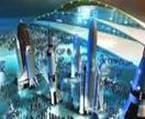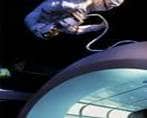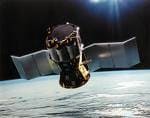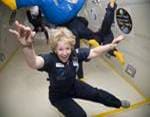INTRODUCTION
Space science is an all-encompassing term that describes all of the various science fields that are concerned with the study of the Universe, "excluding the Earth". Space research is the science that deals with the material universe beyond the earth's atmosphere. It is the study of the motion, nature and constitution of heavenly bodies.




Since the 20th century, this field of profession deals with observational and theoretical branches where the former is focused on acquiring and analyzing data, mainly using basic principles of physics and the later is oriented towards the development of computer or analytical models to describe astronomical objects and phenomena. The two fields complement each other, with theoretical astronomy seeking to explain the observational results, and observations being used to confirm theoretical results. Scientists engaged in space research come from diverse academic backgrounds. Whether it is mathematicians or physicists trying to decode the fundamental laws of the universe, biologists studying bone loss during the weightlessness of space, chemists developing new polymeric materials, or engineers designing better bearings for use in space joints, the broad range of space R&D activities illustrates the growing interdependence between studies done on Earth and in space. It is a promising and amazing career for those who are interested in the mysteries of the universe and has a desire to unravel them. Since each country is going in for nuclear testing, the need for scientists in the filed of Astronomy is increasing.
A beginner in the field of astronomy may be inducted as a researcher into an existing team which would be already working on a project. Ph.D. holders begin their careers in a postdoctoral research position, in which they may work with experienced physicists as they continue to learn about their specialty and develop ideas and results to be used in later work. Initial work may be under the close supervision of senior scientists. Depending on their areas of specialization, astronomers are classified into various groups like observational astronomers, stellar astronomers, solar astronomers etc.
Most jobs in the basic research and development usually require a doctoral degree. The Ph.D. holders ultimately teach at the college or university level. Master's degree holders are qualified for many jobs in manufacturing and applied research and development. Some master's degree programs prepare students for specific research skills that do not require a Ph.D. Bachelor degree holder in this field are often qualified as technicians, research assistants or other types of jobs. As a space scientist one can work for the government, defence and space research organizations, electrical and electronic equipment manufacturers etc. They may work for commercial/ non-commercial research, development and testing laboratories, observatories, planetarium, science park etc.

Dr. Pickering was one of the titans of our nation's space program," said JPL Director Dr.Charles Elachi. "It was his leadership that took America into space and opened up the moon and planets to the world." Pickering started at JPL in 1944, when the laboratory was developing missile systems for the U.S. Army. He organized the electronics efforts at JPL to support guided missile research and development, becoming project manager for Corporal, the first operational missile JPL developed. It was not a simple project. In an interview in 1994, Pickering joked about the trials and tribulations of testing the early guidance systems. For the 100th Corporal that we tested, I pushed the [launch] button, and the darn thing went east instead of north. I never pushed the button again," he recalled. Eventually, under Pickering's direction, JPL developed the successful Sergeant solid-propellant missile. In 1954, Pickering was named director of JPL, and he soon had his hands full with the space race. In November 1957, following the first Soviet Sputnik launch, JPL and the Army Ballistic Missile Agency were given the assignment to place the first U.S. satellite into orbit. Pickering directed the JPL effort, which, in just 83 days, provided the satellite, telecommunications, and the upper rocket stages that lofted Explorer 1 into orbit on January 31, 1958. It was considered one of Pickering's greatest achievements and laid the groundwork for future robotic exploration of the moon and planets. William Pickering Image right: Pickering (left), James Van Allen (center), and Wernher von Braun (right) hoist a model of Explorer 1 in celebration, after it became the first American satellite to orbit Earth in 1958. Photo credit: NASA/JPL.In 1958 JPL, managed by the California Institute of Technology (Caltech), was transferred from the Army to the newly created National Aeronautics and Space Administration. In succeeding years, JPL conducted an intensive series of space probes including Ranger and Surveyor missions to the moon, and the Mariner missions to Earth's neighboring planets.
On December 14, 1962, the Mariner 2 spacecraft successfully completed a flyby of Venus, culminating a 109-day journey of more than 290 million kilometers (180 million miles). It was humankind's first penetration to the vicinity of another planet. On July 14, 1965, following a 228-day journey of more than 525 million kilometers (325 million miles) by Mariner 4, Pickering's team obtained the first close-up pictures of Mars. Four more Mariner missions reached Venus and Mars before Pickering retired from JPL in 1976 at age 66.Pickering received numerous awards throughout his career, including NASA's Distinguished Service Medal. In 1975, he was awarded the National Medal of Science by President Gerald Ford, and in 1976 he was given honorary knighthood from the Queen of England. He also received awards from numerous sciences and engineering societies.Pickering was born in Wellington, New Zealand in 1910. He came to the United States in 1929 to study at Caltech. Pickering was naturalized a U.S. citizen in 1941. He obtained his bachelor's and master's degrees in electrical engineering, and he received a Ph.D. in physics from Caltech before becoming a professor of electrical engineering there in 1946.

Posthumously awarded the Congressional Space Medal of Honor, the NASA Space Flight Medal, and the NASA Distinguished Service Medal. In 1988, Kalpana Chawla started work at NASA Ames Research Center in the area of powered-lift computational fluid dynamics. Her research concentrated on simulation of complex air flows encountered around aircraft such as the Harrier in "ground-effect." Following completion of this project she supported research in mapping of flow solvers to parallel computers, and testing of these solvers by carrying out powered lift computations. In 1993 Kalpana Chawla joined Overset Methods Inc., Los Altos, California, as Vice President and Research Scientist to form a team with other researchers specializing in simulation of moving multiple body problems. She was responsible for development and implementation of efficient techniques to perform aerodynamic optimization. Results of various projects that Kalpana Chawla participated in are documented in technical conference papers and journals.
Selected by NASA in December 1994, Kalpana Chawla reported to the Johnson Space Center in March 1995 as an astronaut candidate in the 15th Group of Astronauts. After completing a year of training and evaluation, she was assigned as crew representative to work technical issues for the Astronaut Office EVA/Robotics and Computer Branches. Her assignments included work on development of Robotic Situational Awareness Displays and testing space shuttle control software in the Shuttle Avionics Integration Laboratory. In November, 1996, Kalpana Chawla was assigned as mission specialist and prime robotic arm operator on STS-87. In January 1998, she was assigned as crew representative for shuttle and station flight crew equipment, and subsequently served as lead for Astronaut Office's Crew Systems and Habitability section. She flew on STS-87 (1997) and STS-107 (2003), logging 30 days, 14 hours and 54 minutes in space.
STS-87 Columbia (November 19 to December 5, 1997). STS-87 was the fourth U.S Microgravity Payload flight and focused on experiments designed to study how the weightless environment of space affects various physical processes, and on observations of the Sun's outer atmospheric layers. Two members of the crew performed an EVA (spacewalk) which featured the manual capture of a Spartan satellite, in addition to testing EVA tools and procedures for future Space Station assembly. STS-87 made 252 orbits of the Earth, traveling 6.5 million miles in 376 hours and 34 minutes. STS-107 Columbia (January 16 to February 1, 2003). The 16-day flight was a dedicated science and research mission. Working 24 hours a day, in two alternating shifts, the crew successfully conducted approximately 80 experiments. The STS-107 mission ended abruptly on February 1, 2003 when Space Shuttle Columbia and the crew perished during entry, 16 minutes prior to scheduled landing.
Horoscope - Career for Zodiac Signs
So if you are interested in a career in space science then just check out these sun signs which are in most favour of space science and research.
 Capricorn
Capricorn
 Aquarius
Aquarius
Eligibility : Click here for more information
Institutes : Some of the prominent institutions offering courses in acting can be had from the following links.. Click here for more information